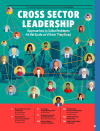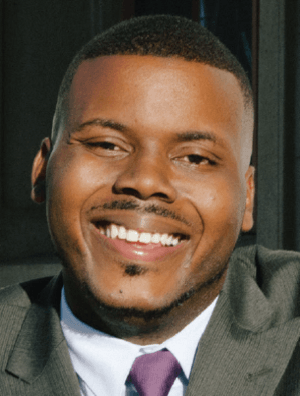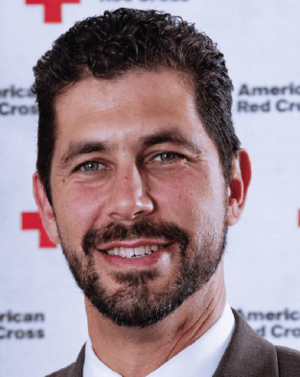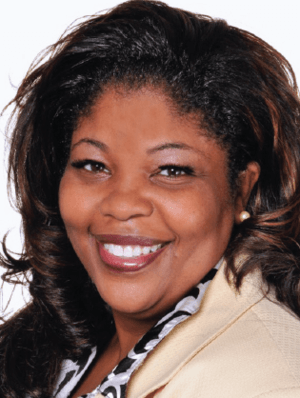Complex challenges are often approached through siloed solutions—whether policy, markets, or social programs. But rarely are these attempts sufficient because the challenges we face are the result not of one policy, investment, or program, but of the interactions between them. This is why we’ve been seeing increasingly urgent interest in cross-sector collaboration.
Cross Sector Leadership: Approaches to Solve Problems at the Scale at Which They Exist

This special supplement, sponsored by the Presidio Institute, takes a close look at cross sector leaders: how they are different from other types of leaders, the role that they play in advancing social change, and why they are so important today.
-
The Need for Cross-Sector Collaboration
-
The Essential Skills of Cross Sector Leadership
-
Cocreating a Change-Making Culture
-
Creating a Cross Sector Leadership Network
-
Profile: Hollaback Cofounder Emily May
-
The Progressive Resurgence of Federalism
-
Profile: FUSE Fellow Siobhan Foley
-
Profile: Oakland Mayor Libby Schaaf
The question we face is: How can we best help such collaborations address our pressing challenges at the magnitude and complexity at which they exist? At the Presidio Institute we believe that developing effective cross sector leaders is a critical piece of the answer to effectively meeting these challenges. Leaders who have trained for and accumulated experience in leading a single organization, or in a single sector, often find the shift in perspective challenging and the learning curve steep.
To help flatten that curve, this article offers a framework and examples of the skill sets that cross sector leaders need and an invitation for new and experienced leaders to join their colleagues in a growing community of practice. This article is also helpful for leaders who are already deep into the collaborative process, and who want to continue to diagnose the challenges in their current efforts and think strategically about using diverse resources to scale their impact.
Building on the research and observations of Nick Lovegrove and Matthew Thomas from Prospect Madison, Alison Gold and Tynesia Boyea-Robinson from Living Cities, Neil Britto from Intersector, Lenny Mendonca, and Lisa Spinali, the Presidio Institute identified nine skill sets that are critical for cross sector leaders to shape collaborations and drive impact.

These nine skill sets are grouped in three broad areas: building teams, solving problems, and achieving impact. These skill sets were shared with leaders through the Presidio Institute Cross Sector Leadership Fellowship Program for four cycles.
Building Teams
Michael Tubbs is the first African-American mayor of Stockton, Calif., winning his election at age 26 (and his prior City Council seat at 22). Tubbs was raised in South Stockton, where in 2013, 38 percent of the population was below the poverty line, more than 60 percent spoke a language other than English at home, 60 percent of residents lacked a high school diploma, and life expectancy was more than 10 years lower than the state average.
 Michael Tubbs (Photograph courtesy of Tubbs)
Michael Tubbs (Photograph courtesy of Tubbs)
Tubbs knew the numerous and complex challenges of his home community—but as a council member, he had only one shared staff person and few resources. What he did have was a bold vision, which he eventually called Reinvent South Stockton Coalition. He also had the capacity to be a neutral convener—to get Stockton’s community organizations, faithbased organizations, government entities, and community residents together (whether or not they had previously gotten along)—and challenge them to work as a collective.
“At the very early stage it was me asking: ‘How much more could you do if we did it together?’” says Tubbs. “And then listening to what happened, suspending my natural inclination to say, ‘That is not where we are now,’ and really just actually listening and empathizing, listening to the pain.” According to Tubbs, it was this open and empathetic dialogue that began to weave connections and a new sense of what might be possible if community members and organizations worked together.
Tubbs knew that there was competition for scarce resources in the community, but he also let it be known that his intention was for the collective efforts to increase the size of the pie. It took more than two years for Reinvent South Stockton to receive significant funding, but those that stayed the course, especially those that applied for grants together, ended up seeing increased interest because funders were looking to support collective efforts.
In 2016, Tubbs moved from the City Council to the mayor’s office, where he continues to champion Reinvent South Stockton’s efforts. Tubbs and his team are beginning to track positive outcomes, and he is confident about the work. “I’m not too worried about metrics yet because the relationships are built and the trust is there and it took some time to establish—and the communities are excited. We all agreed to this process and strategy, so now the question is, how do you make it work for everyone?”
Tubb’s and Reinvent South Stockton’s success highlights the first dimension of the Presidio Institute leadership rubric—building effective teams. When it comes to building teams, there are three essential skills:
1. Developing Trust | Trust is important in any transaction, and it is critical in a collaboration, where parties must rely on one another to achieve something they cannot accomplish on their own. Developing trust can be a time-intensive process, but it is the foundation for any team or partnership.
Key questions to ask are:
- How do we create space to both imagine (perspective taking)and inquire (perspective seeking) to understand one another’s experiences, desires, and pressures?
- How do we build and maintain empathy for one another and commitment to the work?
- How do we build the resilience to speak frankly with courageous authenticity?
- How do we demonstrate honesty and integrity while tailoring communication to meet the perspectives of various stakeholders?
- How do we take small steps and produce early wins to build trust and momentum?
2. Managing Power Dynamics and Conflict | Leaders must understand the power and privilege that they own, based on their personal and professional demographics, background, institutional resources, and social network. They must also try to understand others’ expectations based on their own backgrounds, roles, and experiences. Challenging conversations and conflict can destroy or enable deep relationships depending upon how they are addressed. Agreement is not always the goal; an environment that allows for uncomfortable conversations and encourages curiosity can deepen connections by creating a space for empathy and for understanding differences.
Key questions to ask are:
- How do we acknowledge and address power dynamics and various forms of privilege?
- Who needs to be at the table, and how do we bring a lens of diversity, equity, and inclusion to the work that we are doing?
- How do we ensure that relevant voices are heard and respected?
- How do we approach and enable conflict to occur productively, and how do we address and repair breaches of shared cultural norms?
3. Fostering an Innovation Culture | Selfimposed feelings of what may (and may not) be possible can limit the scale of success. Therefore, it is also essential to create an environment of suspended belief of current realities and encourage outside-the-box ideas, question perceived limitations, and imagine a new reality where audacious, system-wide goals can be achieved.
Key questions to ask are:
- How do we create a culture of learning and continuous improvement that embraces failure?
- How do we make ourselves open to new information, ideas, and ways of developing solutions?
- How do we imagine solutions that redefine the system we are working within?
Solving Problems
Three years ago, the American Red Cross was conceiving of a new program, Prepare LA, to set a strategy for preparing the Los Angeles region for the next big disaster. Originally, the problem was defined with an internal lens—defining the number of cots, blankets, and other Red Cross resources that needed to be made available within the region. Spearheaded by Jarrett Barrios, a 2014 Presidio Institute Fellow, Red Cross leaders shifted the definition of the problem from an inward focus to a community focus—how best to prepare local communities most in need for the next big disaster. In order to more clearly define the problem and arrive at a strategy, the Red Cross utilized the three core skills of the cross sector leadership approach to solving problems: understanding impact on people; taking a systems approach; and leveraging data.
 Jarrett Barrios (Photograph courtesy of Barrios)
Jarrett Barrios (Photograph courtesy of Barrios)
The Red Cross team began by analyzing US Centers for Disease Control and Prevention (CDC) public health mapping data for Los Angeles County, assessing which neighborhoods were most vulnerable based on social factors such as poverty, race, and immigration status. Barrios hypothesized that the same areas vulnerable in a public health crisis were also likely to be the most vulnerable in a natural disaster, and the Red Cross team was able to validate that assumption with its own data. While the CDC’s demographic maps were not predictive of the locations of disasters (liquefaction could occur in both poor and rich neighborhoods), they were often predictive of vulnerability (the oldest homes in the poorest neighborhoods were least likely to be retrofitted). Even single family house fires, where the Red Cross assisted, matched the CDC public health map for the most vulnerable neighborhoods.
With the data providing an indicator of the geographic areas of most concern, the Red Cross analyzed the systems of support available for those vulnerable communities, mapping the key assets and challenges of the identified communities (including mass transit needs and hospitals), as well as identifying key community leaders and the resources in the system that would need to be employed to meet the challenge of a local disaster.
Finally, Barrios’ team convened community leadership coalitions, composed of grass tops local leaders, that were essential to spreading the word of preparedness. To date, the Red Cross of Los Angeles has convened 10 coalitions and five more are ramping up now in some of the most vulnerable communities, providing a community of practice and resources for shared learning. These communities are connected to the Red Cross, the assets are understood and deployable, and they are already yielding benefits in the local communities. For example, the coalition in East Los Angeles has recruited and trained 20 people for Community Emergency Response Team training (CERT) and has provided the first CERT trainings in Spanish in the region, ensuring that there are local leaders trained and engaged if and when search and rescue capacity is needed.
By utilizing data, mapping the system, and building engagement with local community leaders, the Red Cross has done more than stage its own resources—it has mobilized the most vulnerable communities so that they will be better prepared and more resilient when a disaster might strike.
Correctly identifying and solving problems requires the following three skills:
4. Understanding Impact on People | Social challenges are as intimate as they are big. Design should focus on understanding users’ needs and solving the challenge they are encountering at an individual or family level, as well as at a systems level. In communities it is critical to engage people directly affected by a problem, as their experience can unveil other challenges upstream, and solutions previously undiscovered by experts. Engaging beneficiaries as codesigners creates ownership for solutions that will require community buy-in to implement, improving problem identification and solution generation, and engaging an often-underutilized source of human capital for implementation.
Key questions to ask are:
- How do we better understand the problem by understanding the experience of those it directly affects?
- How do we help people and organizations see how they are contributing to the problem?
- How do we engage the people directly affected by the problem as co-designers to identify and implement the appropriate solution?
5. Taking a Systems Approach | Systems are perfectly designed to produce the results they produce. To achieve different results, leaders need to map the full system and acknowledge where various components interact. By understanding the system that is producing an undesired outcome, collaborators can alter inputs, redefine the system, or activate their networks to achieve more desirable results.
Key questions to ask are:
- How do we support one another to see the system, to see our contribution to the system, and to identify those stakeholders in the system that must be at the table?
- How do we enable all collaborators to take off their organizational or individual hat and put on their systems hat?
- How do we examine the system to see how current outcomes are produced, where the key leverage points are, and what alterations might produce alternative outcomes?
6. Defining Results and Using Data | Collaborations must be clear about what they are trying to solve, how they will measure success toward those collective goals, and how that data will inform future decision making. Reaching clarity around the shared desired outcome empowers collaborators to work in unison even if their motivations and strategies differ.
Key questions to ask are:
- How do we help a cross-sector effort define its results and identify leading indicators?
- How do we use qualitative and quantitative data to inform decision making?
Achieving Impact
 Tiffany Manuel (Photograph courtesy of Manuel)
Tiffany Manuel (Photograph courtesy of Manuel)
2015 Presidio Fellow Tiffany Manuel is vice president of Knowledge, Impact, and Strategy at Enterprise Community Partners, a nonprofit committed to creating thriving communities by providing capital, policy support, and solutions to community issues. Manuel and her team at Enterprise gather the data and parse the practices that achieve the greatest impact. Her team engages with more than 50 crosssector community-led collaborations around the country to effectively distribute information on best practices and build their capacity to use data and evidence in their efforts to address the most pressing issues facing their communities.
As a Presidio Institute alum, Manuel uses the cross sector leadership framework to identify the key leverage points and foster knowledge sharing. For example, in Seattle an existing coalition was attempting to work on the issue of income and resource disparity in the region with a campaign contrasting King County with the surrounding communities. While this perspective highlighted the inequalities in the system, Manuel and her team helped to identify that this framing was causing disengagement by key stakeholders needed to shift the system.
The key pivot was to reframe the outreach to a “story of us”—a story of how the region and each stakeholder would benefit from having a thriving King County. With this key pivot, Manuel was able to help the Seattle coalition align the motivations and values of the core constituents, employers, and other stakeholders so that they could see their own success as intrinsically linked with a thriving King County. As a result, the coalition was able to successfully request the state to outline a specific set of grants for health disparity, engaging local hospitals to provide the needed data on where the resources were most needed, and the relevant communities were able to receive the needed resources.
Manuel and her team at Enterprise Community Partners were able to achieve this impact because they were able to identify a key leverage point based on learning from other cross-sector collaborations. They aligned motivations and values in such a way that they were able to engage stakeholders with the resources necessary to achieve a lasting impact.
Achieving impact requires the following three core skills:
7. Aligning Motivations and Values | Creating a strong virtuous cycle drives the sustainability of any solution. Collaborations can achieve greater impact by paying attention not only to collective goals and what each partner contributes, but also to what each partner organization gets out of the effort. Rather than looking only for similarities, it’s equally valuable to identify and articulate the differences in motivations and perspectives that allow a collaborative effort to create value. This approach of creating value for individual partners and the collective is called “community-centered selfishness.”
Key questions to ask are:
- How do we understand one another’s motivations and values?
- How can the differences in parties’ motivations, values, and resources create value?
- How do we align financial, intellectual, human, and social capital to achieve impact?
8. Using Leverage Points | Collaborations influence systems by applying pressure at leverage points to alter the flow and achieve alternative results. Leverage points include capital flows, policies and regulation, public opinion, and behavior change. Identifying the highest-value leverage points requires collaborators to have a deep understanding of the system and map the best use of the collective assets of the partners.
Key questions to ask are:
- How do we identify the highest value leverage points to produce the intended results?
- How do we develop strategies relating to those leverage points?
9. Sharing Knowledge and Learning | Collaborations should aim not only to achieve a tangible result, but also to pave the way for future partnerships. This longer-term view of impact encourages partners to view themselves as part of an experiment where lessons learned can inform future experiments. This lens can allow for more open feedback and sharing of failures, successes, and suggested improvements.
Key questions to ask are:
- How do we build mind sets and create a culture where collaborators can share what they’re learning in as close to real time as possible?
- How can we learn from communications and behavioral research to tell our stories effectively?
- How do we make what we’re learning open and accessible to others?
Conclusion
With the increasing need for the sophisticated leadership capacities necessary to meet complex challenges at the scale at which they exist, our intention is for these examples and the rubric of skill sets provided to be a catalyst for your own exploration and to serve as a starting point for an ongoing community of practice. Join the movement at www.xsectorleadership.com.
Support SSIR’s coverage of cross-sector solutions to global challenges.
Help us further the reach of innovative ideas. Donate today.
Read more stories by David B. Smith & Jeanine Becker.

